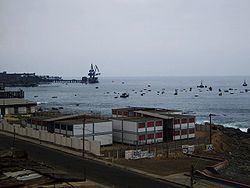Province Tocopilla Demonym(s) Tocopillian Elevation 154 m Local time Saturday 11:53 PM | Founded 1843 Time zone CLT (UTC−4) Area 4,039 km² Number of airports 1 | |
 | ||
Weather 19°C, Wind S at 6 km/h, 54% Humidity | ||
Tocopilla chile port city between iquique and antofagasta fatih aksoy
Tocopilla is a city and commune in the Antofagasta Region, in the north of Chile. It is the capital of the province that bears the same name.
Contents
- Tocopilla chile port city between iquique and antofagasta fatih aksoy
- Map of Tocopilla Antofagasta Region Chile
- Toponymy
- 2007 earthquake
- Demographics
- Administration
- Economy
- New Years Eve Traditions
- Sports
- In media
- References
Map of Tocopilla, Antofagasta Region, Chile
Tocopilla celebrates every year its anniversary on September 29th with a big show the day before, which includes a parade down in the main street of the city, food and fireworks are display at midnight.
The city is divided into two main parts consisting of the central city and smaller portion known as La Villa Sur(in which the more luxurious houses are located). The two parts are divided by the thermoelectric power plant and a large saltpeter processing and shipping plant, but the coastal highway connects the two portions. The northern portion of Tocopilla is home of the municipal buildings, the central square and a large number of stores and shops. The steep grade of the city from beach to vertical hillside is covered in houses and apartments crammed together to save space. A large artificial beach called "Covadonga"and a small artificial beach called "Caleta Boy" are the main attraction during summer months and serve as a focus away from the heat of the Atacama. On the north side of the city, there is a black sandy beach called "El Panteón".
Tocopilla is also the birthplace of the renowned artist Alejandro Jodorowsky and the football star Alexis Sánchez.
Toponymy
Tocopilla means "the devil's corner". Despite this it is believed that the city's previous names included Caleta Duendes ("Goblin's Cove") or Quebrada Honda ("Deep Ravine").
2007 earthquake
On 14th November 2007, a magnitude 7.7 earthquake occurred 40 km (25 mi) east-southeast of Tocopilla, followed by aftershocks of magnitude up to 6.8. As a consequence, 1,200 homes were destroyed in Tocopilla, leaving 4,000 of its 27,000 inhabitants homeless. There were two fatalities, and at least 115 were injured. Despite the government's efforts to provide immediate help, there were some problems with the delivery of food in the first two days. Those were later resolved and a larger plan of cleaning and reconstruction started.
Demographics
According to the 2002 census of the National Statistics Institute, Tocopilla had 23,986 inhabitants (12,050 men and 11,936 women). Of these, 23,352 (97.4%) lived in urban areas and 634 (2.6%) in rural areas. The population fell by 4.0% (999 persons) between the 1992 and 2002 censuses.
Administration
As a commune, Tocopilla is a third-level administrative division of Chile administered by a municipal council, headed by an alcalde who is directly elected every four years. The 2013-2016 alcalde is Fernando San Román Bascuñán (Ind./PRO).
Within the electoral divisions of Chile, Tocopilla is represented in the Chamber of Deputies by Mr. Marcos Espinosa (PRSD) and Mr. Felipe Ward (UDI) as part of the 3rd electoral district, (together with María Elena, Calama, Ollagüe and San Pedro de Atacama). The commune is represented in the Senate by Mr. Pedro Araya Guerrero(Ind.) and Mr.Alejandro Guillier(Ind.) as part of the 2nd senatorial constituency (Antofagasta Region).
Economy
This city generates electricity for the entire region and is therefore known as "the city of energy". When saltpeter exportation in Chile was at its highest point, Tocopilla was especially significant as an export point. Nowadays, even when the saltpeter is not so profitable, Tocopilla is still home of companies focused on its extraction.
Its position along the coast allows it to have an active fishing activity, that along with the mining activity are the main resources. It is a fishing port, with fishmeal and canned fish factories. Through its port the copper from Chuquicamata and saltpeter from El Toco are exported. Tocopilla has metallurgic, chemical and nitrate treatment industries, along with the power plant. Due to these activities, Tocopilla is a dormitory city, since many people work outside the city.
Tocopilla is located in the middle of three big development poles: Iquique, Antofagasta and Calama. For long time there was a project to transform Barriles into an industrial area, trying to concentrate all factories and industries that are adjacent to the city; especially those located further away in María Elena and Pedro de Valdivia Offices, but so far there is a lack of interest to move to a place so far from urban areas.
New Year's Eve Traditions
As part of the New Year celebrations, people in the city celebrate the rite of purification by burning the bad mementos from the old year in order to have a better year. It has become a tradition, supported by the alcaldía (city hall), to have pieces of art burnt at midnight.
Sports
In Tocopilla, baseball is played. Communal teams have won more than half the National Championships from the Chilean Baseball Federation, some of them consecutively.
Other two important sports are volleyball, with relative success at school and federated level and association football with a number of players that have gone to bigger clubs, such as Alexis Sánchez
In media
La danza de la realidad, a 2013 Chilean-French film by Alejandro Jodorowsky, was filmed in Tocopilla.
